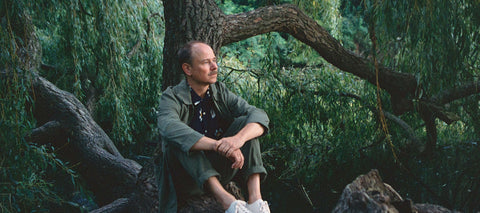PEOPLE
Kustaa Saksi: Healing Through Art
Visual artist Kustaa Saksi creates otherworldly landscapes that inspire imagination
Finnish multidisciplinary artist and designer Kustaa Saksi constructs rich and abstract worlds through his creations. After a decade of working with paper as a graphic designer and illustrator, the Netherlands-based artist found new avenues for self-expression through textile art. At the TextielLab within the Textielmuseum in Tilburg, he delves into weaving techniques and material experimentation, bringing his visions to life in large-scale pieces. With a profound reverence for nature and a fascination with the human mind, Saksi's work often depicts enigmatic and surreal landscapes.
His compositions feature botanical motifs and mythical beings, rendered in psychedelic hues, transporting viewers into fantastical realms of creative exploration. Through some of his pieces, he attempts to comprehend the debilitating migraines he has grappled with since childhood—an endeavour to transmute pain into restoration. In light of the exclusive artwork that he has created for Another Land, Saksi reflects on his creative practice and shares his self-care ritual.
What was it like growing up in Finland? Did your childhood influence your perspective and creative process?
In the small town where I grew up, the winters used to be long, harsh, and cold with a lot of snow. The summers were short, so we had to make the most out of them, in other words, stay out as much as we could. I had an active lifestyle, wandering in the woods, skiing, picking berries, and island-hopping—living with nature and its various seasons. I think these experiences influenced my visual language.
What led you to pursue a life spent creating art?
As a kid, I was making images but I never thought of working as an artist. Somehow life guides you down a path that you’d be naturally good at. I studied graphic design and illustration and from there, I found my voice in textile art.
Speaking of textile art, how did your involvement with the TextielLab in Amsterdam begin?
I was seeking new methods of image-making after ten years of mainly working with paper. Working and experimenting at TextielLab opened up a new world of complicated weaving techniques and material research. I loved the new challenges and restrictions it brought.
How did these “new challenges and restrictions” inspire you?
I have sometimes referred to my process as 'action painting with warp and weft.' I heavily rely on intuition, often by trial and error. Woven textiles convey sensorial information that can only be accessed through touch. The qualities of different yarns and the structure of the weave can convey somatic and tactile impressions: the coldness of metal, the softness of mohair, or the smoothness of silk. Therefore, my choice of material and colour often depends on the feeling I aim to convey. Surprisingly, some of my most exciting discoveries have come from failure.

It must be challenging to live with intense headaches, which is a recurring theme in your work. How did you find yourself channelling pain into art? And in what ways has this process been therapeutic?
Themes revolving around my experiences with migraines, alongside universal themes of dreams, hallucinatory visions, and mythical narratives, have consistently resurfaced in my work over the years. I've always been intrigued by the human brain, especially its ability to process sensory information in unique and unexpected ways.
I have suffered from migraines since the age of seven. Using migraine as a theme for my work was a step for me towards overcoming a fear associated with the condition, even striving to find beauty within it.
What is a day (or week) like for you?
My weeks differ quite a bit depending on which stage of the process I’m in. I usually do the drawing and planning work at my studio in Amsterdam. When it comes to the weaving process, I spend a lot of time at TextielLab in Tilburg with my team, experimenting, closely monitoring and supervising the weaving process; searching for optimal fibre materials and making textile samples to achieve the desired structure and feeling.
What does your self-care ritual entail? How do you unwind or take breaks?
My self-care revolves around spending time with my son, exploring books, taking bike trips through the woods, examining insects in the park, or visiting exhibitions. It’s exciting to discover new perspectives through his point of view.
What was the story that you wanted to tell through your work for Another Land?
For Another Land, I wanted to create imagery that would stimulate the imagination and nurture the senses. It’s an organic and visually rich interpretation of nature’s forms. The theme revolves around the fictitious nature of dreams, where the distinction between reality and illusion becomes blurred, inviting viewers to immerse themselves in a world of wonder and possibility.


Discover more of Kustaa's works here
